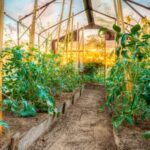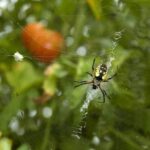Deer are beautiful creatures that have long captivated the attention and curiosity of humans. However, their presence can also pose a significant challenge for gardeners, particularly those with vegetable gardens. As gardeners eagerly sow their plants and tend to their crops, deer can become cunning intruders that eagerly feast upon the bounties of their hard work.
This has led to an ongoing dilemma: do deer eat vegetable gardens? In this article, we will delve into the intricate relationship between deer and vegetable gardens, exploring the curious case of these grazing herbivores and their dietary habits.
For many gardeners, the frustration of discovering their beloved vegetables being devoured by deer is all too familiar. Understanding this common problem faced by gardeners is crucial in addressing and finding solutions to safeguard our precious produce.
Additionally, there is a natural curiosity surrounding deer and what drives them to target vegetable gardens in particular. By examining the intricate relationship between deer and vegetable gardens, we can uncover insights into both sides of this equation – the innate behavior of deer as well as the alluring appeal that cultivated vegetables hold for these graceful creatures.
Before diving deeper into this complex relationship, it is important to identify and differentiate the various species of deer that are relevant to vegetable gardens. By understanding their geographical distribution and preferred habitats, gardeners can gain valuable knowledge about which species are most likely to come into contact with their crops. With this knowledge in hand, it becomes easier to develop effective strategies for protecting our beloved vegetable gardens from these potential culprits.
The Culprits
Deer are known to be frequent visitors to vegetable gardens, causing frustration and damage for many gardeners. In order to effectively address this problem, it is important to understand the different deer species that may be responsible for raiding our gardens.
There are several types of deer that are relevant to vegetable gardens, including the white-tailed deer (Odocoileus virginianus), mule deer (Odocoileus hemionus), black-tailed deer (Odocoileus hemionus columbianus), and the elk or wapiti (Cervus canadensis). These species have varying geographical distributions and preferred habitats, so it is important for gardeners to identify which species are present in their area.
The white-tailed deer is the most common species in North America and is found throughout the United States and Canada. They have a reddish-brown coat with a white underside and a distinctive large tail that sticks up when alarmed. Mule deer are primarily found in western North America, with larger ears than white-tailed deer and a black-tipped tail.
Black-tailed deer are native to the Pacific Northwest region of North America, with dark brown or grayish coats. Elk or wapiti, on the other hand, are one of the largest species of deer and are known for their impressive antlers.
Understanding which particular deer species inhabit your region can help you tailor your strategies for protecting your vegetable garden. Different deterrents may work more effectively against certain species, so identifying them correctly will greatly increase your chances of success in keeping them at bay.
The Hungry Herbivores
Deer are hungry herbivores that rely on their diet of plants and vegetation for survival. Understanding their natural diet is essential in order to comprehend why they may target vegetable gardens.
Deer primarily feed on a wide range of natural forage and vegetation such as grass, shoots, leaves, berries, nuts, and acorns. They have evolved to consume a diverse array of plant species in order to meet their nutritional needs. It is important to note that deer are highly adaptable and can feed on different types of plants depending on their geographical location and the season.
Plant diversity plays a crucial role in the diet of deer. They require a variety of nutrients from different plant sources to maintain optimal health. This need for dietary diversity may lead them into vegetable gardens where they can find an abundant supply of nutritious plants.
In some cases, deer may also consume vegetables out of curiosity or due to environmental factors such as food scarcity or changes in habitat. While their natural diet consists mainly of plant material, deer have been known to eat unconventional items when necessary. For example, during periods of drought or extreme cold weather, they may resort to eating bark from trees or shrubs.
To better understand the natural diet preferences of deer, it is helpful to examine specific species and their feeding habits. For instance, white-tailed deer (Odocoileus virginianus), one of the most commonly encountered species in North America, are known to consume a wide range of herbs, shrubs, fungi, agricultural crops like soybeans and corn as well as browse on branches throughout the year.
By gaining insight into the hunger herbivores’ natural diet preferences, gardeners can take steps towards protecting their vegetable gardens from potential damage caused by these curious creatures.
| Deer Species | Geographical Distribution | Preferred Habitats |
|---|---|---|
| White-tailed Deer (Odocoileus virginianus) | North America | Forests, woodlands, grasslands, farmlands |
| Mule Deer (Odocoileus hemionus) | Western North America | Sagebrush-steppe, mountainous regions, arid and semi-arid areas |
| Roe Deer (Capreolus capreolus) | Europe and Western Asia | Woodland edges, agricultural landscapes |
The Temptation
Deer are known for their beautiful appearances and graceful movements, but they can also be a gardener’s worst nightmare. Many gardeners have experienced the frustration of waking up to find their carefully cultivated vegetable gardens decimated by hungry deer. The question is, why do these majestic creatures have such a strong attraction to vegetable gardens?
One of the main reasons why deer target vegetable gardens is because of the nutritional benefits they provide. While deer are primarily herbivores and rely heavily on natural vegetation for sustenance, they have learned that cultivated vegetables offer an easy and abundant food source. Vegetables like lettuce, carrots, and beans are high in nutrients and provide a quick energy boost for these animals.
Additionally, the convenience factor cannot be ignored. Vegetable gardens typically have a concentrated variety of tasty plants in one location, making it much easier for deer to satisfy their hunger without expending much effort. Rather than having to wander long distances in search of scattered natural vegetation, deer can simply feast on a lush garden filled with numerous appetizing options.
The level of temptation also increases when certain plants are at their most vulnerable stage of growth. For example, young seedlings and tender shoots are particularly appealing to deer because they are easier to consume than larger and more established plants. This is why many gardeners notice an uptick in deer damage during the early stages of planting.
In order to protect your valuable vegetables from hungry deer, it is important to understand their motivations for targeting your garden. By recognizing these factors, you can develop effective strategies to deter them and safeguard your hard work. In the next section, we will explore various defense mechanisms that gardeners can employ to protect their vegetable gardens from these hungry herbivores.
The Battle Begins
Direct Damage
Deer can cause significant direct damage to vegetable gardens. One of the most obvious signs of deer activity is the destruction of plants and the consumption of edible parts. Deer have no qualms about feasting on your carefully cultivated vegetables, often leaving behind only chewed stems and stripped leaves. Common targets for deer include lettuce, peas, beans, carrots, and sweet potatoes. They have even been known to nibble on tomatoes and peppers if these plants are easily accessible.
In addition to eating crops, deer can also trample delicate seedlings or get tangled in garden netting, causing further destruction. Their large size and powerful hooves can wreak havoc on garden beds, compacting soil and damaging irrigation systems.
Moreover, deer may chase away other wildlife that helps control pests in gardens, such as birds or beneficial insects. This disruption of the natural ecosystem can lead to an increase in unwanted insect populations and ultimately impact the overall health of your vegetable garden.
Indirect Impact
While many gardeners primarily focus on the visible damage caused by herbivorous deer, it is important to recognize the indirect impacts they can have on vegetable gardens as well. When yards become regular feeding areas for deer, their movement patterns can change significantly. As a result, they may use well-travelled paths through your garden that eventually form into trails that erode soil and facilitate soil compaction.
Furthermore, when browsing for food becomes a common activity in a particular area of your yard due to frequent visits from deer, it can create imbalance in the ecosystem. Other wildlife may avoid that area due to competition with deer or reduced food availability. The absence of predators also contributes to an imbalance since deer population growth goes unchecked without natural regulation.
Gardeners should also be aware that some diseases and parasites carried by deer could potentially affect vegetable plants indirectly. For example, Lyme disease transmitted by deer ticks can be a concern for gardeners who spend time in their gardens. While it is important not to overstate the risks, being educated about such potential consequences is valuable in maintaining a healthy vegetable garden.
Defense Mechanisms
Deer can be a significant nuisance for gardeners, often causing damage to vegetable gardens by feasting on the plants. In order to protect your hard work and ensure a bountiful harvest, it’s crucial to implement effective defense mechanisms. There are several strategies and deterrents that can be utilized to keep deer at bay and safeguard your vegetable garden.
One of the most common and effective methods of protecting your vegetable garden from deer is through the use of fences. A sturdy and tall fence can create a physical barrier that prevents deer from accessing your plants. It is recommended to install a fence at least 8 feet high, as deer are skilled jumpers. Electric fences can also be an option, delivering a harmless shock to deter them from trying to breach the barrier.
Another approach is the use of odor-based repellents. Deer have highly sensitive noses and certain scents repel them. Commercially available repellents with ingredients such as garlic, eggs, or predator urine can be sprayed around the perimeters of your garden or directly on plants. Additionally, some home remedies like soap shavings, human hair, or even strong-scented plants like lavender or yarrow can serve as natural deterrents.
Companion planting is another effective defense mechanism that helps protect your vegetable garden from deer while promoting biodiversity. By interplanting certain vegetables with strong-smelling herbs or flowers, you can confuse and repel deer. Examples of companion plants include marigolds, garlic, chives, or sage. The strong aroma they emit camouflages the scent of vegetables that deer find appealing and deters them from approaching.
Implementing these defense mechanisms will greatly increase the chances of keeping deer out of your vegetable garden. However, it’s important to remember that no method is foolproof and determined deer may still find ways to access your plants in some circumstances.
Therefore, it may be necessary to combine multiple strategies for maximum effectiveness, adapting them to your specific garden and deer population. By taking proactive measures, you can enjoy the fruits of your labor while minimizing damage caused by deer.
Deer-Resistant Vegetable Options
One of the greatest frustrations for gardeners is waking up to find their prized vegetables decimated by deer. However, there are certain vegetables that deer are less likely to eat, providing gardeners with hope for safeguarding their gardens. By planting these deer-resistant options, gardeners can strike a balance between nature and cultivation.
When it comes to selecting deer-resistant vegetables, it is important to consider the taste preferences of different deer species. While no vegetable is completely immune to all types of deer, some have proven to be less tempting than others. Here is a list of vegetables that are typically less appealing to deer:
- Onions and Garlic: The strong odor from these crops repels many animals, including deer.
- Peppers: The spicy nature of peppers makes them unpalatable for most creatures.
- Squash and Pumpkins: The tough skin and bitter taste of these vegetables often dissuade deer.
- Brassicas: Vegetables like broccoli, cabbage, and kale are typically lower on a deer’s menu due to their strong flavors.
- Herbs: Many herbs such as sage, rosemary, and thyme have fragrances that deter deer.
In addition to specific vegetable choices, gardeners can also use companion planting techniques to create a natural barrier against deer. By interplanting certain varieties together, the scents or tastes emitted by one plant can help repel pests from another crop nearby. For example, planting marigolds alongside susceptible vegetables can deter not only insects but also browsing animals like deer.
While incorporating these deer-resistant options into your vegetable garden can significantly reduce the risk of damage caused by deer, it is important to remember that no method is foolproof. Deer behavior can vary depending on geographical factors and changes in food availability, so vigilance remains key in protecting your garden.
When gardening in areas with a high deer population, it is crucial to keep monitoring and adapting your approach as needed. By combining deer-resistant vegetables, companion planting techniques, and other deterrents or repellents discussed in this article, gardeners can find a balance that allows them to enjoy their gardens while respecting the natural habitat of these beautiful creatures.
The Ethical Dilemma
Understanding the Moral Implications
As gardeners grapple with the challenge of protecting their vegetable gardens from deer, an ethical dilemma arises. On one hand, there is a desire to minimize damage and preserve the labor invested in cultivating vegetables. On the other hand, there is a responsibility to consider the well-being of wildlife and coexist harmoniously with nature. Striking a balance between these two perspectives requires careful consideration.
The Importance of Coexistence
Finding ways to peacefully coexist with deer is crucial for maintaining biodiversity and ecological balance. Deer play a vital role in ecosystems as herbivores, shaping plant communities and contributing to seed dispersal. Removing them entirely from an area can disrupt natural processes and have far-reaching consequences.
Additionally, by respecting deer as fellow inhabitants of our environment, we foster a culture of compassion and appreciation for all living beings. This mindset encourages responsible stewardship and ethical decision-making regarding wildlife management.
Sustainable Solutions for Gardeners
Fortunately, there are ways to address the ethical dilemma while still protecting vegetable gardens from deer damage. Implementing sustainable solutions that prioritize both gardeners’ needs and wildlife conservation can help strike this delicate balance.
One approach is to focus on deterrents rather than harm or removal. Installing fencing around the garden can effectively prevent access by large mammals like deer while allowing them freedom outside those boundaries. Additionally, using odor-based repellents made from natural ingredients such as garlic or predator urine can deter deer without causing them any harm.
Companion planting is another strategy that promotes harmony between gardeners and deer. By intermingling vegetables with naturally repellent plants such as marigolds or lavender, one can discourage deer from entering the garden while creating an attractive habitat for beneficial insects.
Ultimately, finding an ethical balance between deer and gardeners involves recognizing the value of each species’ presence in our shared environment. By implementing sustainable and compassionate solutions, we can navigate the ethical dilemma and cultivate a more harmonious coexistence that benefits both humans and wildlife.
Conclusion
In conclusion, the intricate relationship between deer and vegetable gardens is a common problem faced by many gardeners. Through this article, we have explored the reasons behind deer’s attraction to cultivated vegetables and the potential damage they can cause. However, it is important for us to find a balance between deer conservation and gardening satisfaction.
Understanding the different deer species and their natural diet has shed light on why these hungry herbivores are drawn towards vegetable gardens. Deer primarily rely on native vegetation and plant diversity for their nutrition. The temptation of nutrient-rich cultivated vegetables and the convenience they provide make gardens an attractive food source for them.
To protect our vegetable gardens from deer damage, we have discussed various effective deterrents and repellents such as fencing, odor-based repellents, and natural plants. Additionally, we have explored the concept of companion planting to create an environment that is less appealing to deer.
However, it is crucial to approach this issue with an ethical mindset. Striking a balance between deterring or harming deer in our efforts to protect our gardens and coexisting with wildlife is essential. We should strive for harmonious approaches that allow both gardeners to enjoy their vegetable gardens safely while appreciating the importance of conserving these magnificent creatures.
Ultimately, it is important for gardeners to be empowered with knowledge about dealing with deer in order to enjoy their vegetable gardens without causing unnecessary harm or compromising conservation efforts. By embracing a balanced approach that considers both the needs of gardeners and the importance of wildlife preservation, we can ensure a harmonious coexistence with nature while still reaping the bountiful rewards from our vegetable gardens.
Frequently Asked Questions
What vegetables in a garden will deer not eat?
Some vegetables that deer typically avoid eating in gardens include onions, garlic, asparagus, rhubarb, and peppers. This is because these vegetables often have strong smells or tastes that deter the deer from consuming them.
Additionally, certain types of herbs like sage, thyme, and rosemary may also be unappealing to these animals. However, it is important to note that while deer are less likely to eat these vegetables, there is no guarantee they won’t if they are particularly hungry or if alternative food sources are scarce.
How do I keep deer from eating my garden?
To prevent deer from eating your garden plants, there are several strategies you can employ. One effective method is to install a sturdy fence around your garden area. Opt for a fence at least 8 feet tall and make sure it’s sturdy enough to withstand the pressure exerted by deer attempting to jump over it.
Another option is using repellents such as sprays or granules that contain substances like dried blood or garlic which emit odors deterring deer from approaching the plants. Additionally, planting aromatic herbs or flowers known for their repelling properties around the perimeter of your garden may help keep deer at bay.
Do deer eat cucumbers and tomatoes?
While deer usually have preferences when it comes to food, they are opportunistic herbivores and will eat a variety of plant materials if necessary. Cucumbers and tomatoes can be attractive to deer as they provide easy access to water due to their high moisture content.
However, whether or not a particular deer population will eat cucumbers and tomatoes largely depends on factors such as the availability of alternative food sources and the local environmental conditions. To protect your cucumber and tomato plants from being consumed by deer, consider using fencing methods discussed earlier or other deterrents such as repellent sprays or devices that emit ultrasonic sounds meant to startle the animals and prompt them to leave the area.

If you’re looking to get into vegetable gardening, or are just looking for some tips on how to make your current garden better, then you’ve come to the right place! My name is Ethel and I have been gardening for years. In this blog, I’m going to share with you some of my best tips on how to create a successful vegetable garden.





